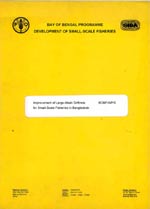
WORKING PAPERS - BOBP/WP/5
Improvement of Large-Mesh Driftnets for Small-Scale Fisheries in Bangladesh
by
G. Pajot
Fishing Technologist
 |
WORKING PAPERS - BOBP/WP/5 Improvement of Large-Mesh Driftnets for Small-Scale Fisheries in Bangladeshby |
|
Executing Agency: FOOD AND AGRICULTURE ORGANIZATION OF THE UNITED NATIONS Funding Agency: SWEDISH INTERNATIONAL DEVELOPMENT AUTHORITY Development of Small-Scale Fisheries in the Bay of Bengal Madras, India, September 1980 |
| The designations employed and the presentation of material in this publication do not imply the expression of any opinion whatsoever on the part of the Food and Agriculture Organization of the United Nations concerning the legal status of any country, territory, city or area or of its authorities, or concerning the delimitation of its frontiers or boundaries. |
All rights reserved. Reproduction and dissemination of material in this information product for educational or other non-commercial purposes are authorized without any prior written permission from the copyright holders provided the source is fully acknowledged. Reproduction of material in this information product for resale or other commercial purposes is prohibited without written permission of the copyright holders. Applications for such permission should be addressed to the Chief, Publishing and Multimedia Service, Information Division, FAO, Viale delle Terme di Caracalla, 00100 Rome, Italy or by email to [email protected]
© FAO 2004
|
Driftnets account for nearly 30 per cent of the total marine catch in Bangladesh. With the polyamide (PA) or nylon twine used for constructing the nets getting scarcer and costlier, the driftnetters tend to carry less and less gear, affecting fish catch and incomes. It is therefore desirable to devise ways to ensure that driftnets cost less and/or produce more. This was the rationale for an experimental project conducted during the 1979/80 winter season. The boats used three kinds of fishing gear-the traditional large-mesh driftnets (45 ply), modified nets of thinner netting twine (27 ply) and nets of polyethylene material. Details of fish catch were recorded daily for thethree types of nets with the assistance of extension workers from the Kalidaha fishing project. A comparative study of the data obtained reveals that nylon nets of thinner twine size, which cost approximately 40% less than the traditional nets, caught about 40% more fish. Thus the thinner twine nets are clearly preferable to the traditional. Following from these results, a promotional effort to extend the merits of this net is recommended, with the Bay of Bengal Programme assisting in the effort. As for the nets of polyethylene netting material, they also caught 45% more fish tha n the traditional nets, but sustained greater damages. Further studies are recommended on the efficacy of polyethylene netting material and on the optimum mesh sizes for large-mesh driftnets. Study tours of large-mesh driftnet fisheries in other countries are also recommended for Bangladesh national officers. |
PREFACE
1. INTRODUCTION
2. THE DRIFTNETS
3. CONDUCT OF EXPERIMENTS
4. FINDINGS
5. RECOMMENDATIONS
TABLES
1. CATCH RECORDS OF EXPERIMENTAL FISHING WITH LARGE-MESH DRIFTNETS IN KALIDAHA. NYLON NETS OF THICKER TWINE (TRADITIONAL) VS. NYLON NETS OF THINNER TWINE .
2. CATCH RECORDS OF EXPERIMENTAL FISHING WITH LARGE-MESH DRIFTNETS IN KALIDAHA. POLYETHYLENE NETS VS. NYLON (TRADITIONAL) NETS
APPENDICES
1. DESIGN OF THE TRADITIONAL LARGE-MESH DRIFTNET
2. DESIGN OF THE EXPERIMENTAL DRIFTNET (NYLON)
3. DESIGN OF THE EXPERIMENTAL DRIFTNET (POLYETHYLENE)
4. MAP INDICATING THE LOCATION OF THE FISHING AREA
5. PHOTOGRAPHS OF BOATS USED FOR THE FISHING TRIALS
PUBLICATIONS OF THE BAY OF BENGAL PROGRAMME